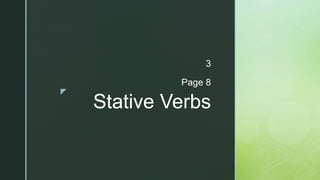
273 grammar explanation on page 8
- 2. z That sounds like a great project. We don’t have two chances to make a good impression. Stative verbs describe states and conditions. Generally, they do not describe actions.
- 4. z Use the simple present with stative verbs. Here are some common stative verb categories: Description: appear, be, exist, look, seem, sound She seems like a hard worker. Measurement: cost, weigh It doesn’t cost anything to send your application. Knowledge: believe, forget, know, remember, think I know stereotypes aren’t true.
- 5. z Use the simple present with stative verbs. Here are some common stative verb categories: Emotions: feel, hate, like, love, prefer Employers prefer motivated workers. Possession/Relationship: belong, contain, have, need, own, want I don’t have a good impression of him. Senses: hear, see, smell, taste Do you see the water from your office? Perception: notice, see, understand. When you explain the problem that way, I understand your viewpoint.
- 6. z Verbs with Stative and Action Meanings 3.2 Page 8
- 7. z Some verbs have both stative and active meanings. You can use the present progressive with the action meanings of these verbs.
- 8. z Some examples of verbs with stative and action meanings include: be, have, see, taste, think, weigh.
- 9. z SIMPLE PRESENT (STATIVE MEANING) PRESENT PROGRESSIVE (ACTION MEANING) I think first impressions are important. (think = believe, or have an opinion) I am thinking about how to make a good first impression. (think = use the mind) Do you have an interesting career? (have = own) Are you having trouble at work? (have = experience) She is the new manager. (description) She is being difficult. (be = act) He noticed that he doesn’t see very well anymore. (see = view with the eyes.) He is seeing the eye doctor for an exam next week. (see = meet with)
- 10. z Another way to think about his problem is that we use the present progressive when the situation is temporary.
- 11. z SIMPLE PRESENT (STATIVE MEANING) PRESENT PROGRESSIVE (ACTION MEANING) I think first impressions are important. (think = believe, or have an opinion) I am thinking about how to make a good first impression. (I am thinking about it right now but not all the time.) Do you have an interesting career? (have = own) Are you having trouble at work? (temporary trouble—you don’t have trouble at work all the time.) She is the new manager. (description) She is being difficult. (right now—she isn’t usually difficult.) He noticed that he doesn’t see very well anymore. (see = view with the eyes.) He is seeing the eye doctor for an exam next week. (He is seeing the eye doctor one time.)
